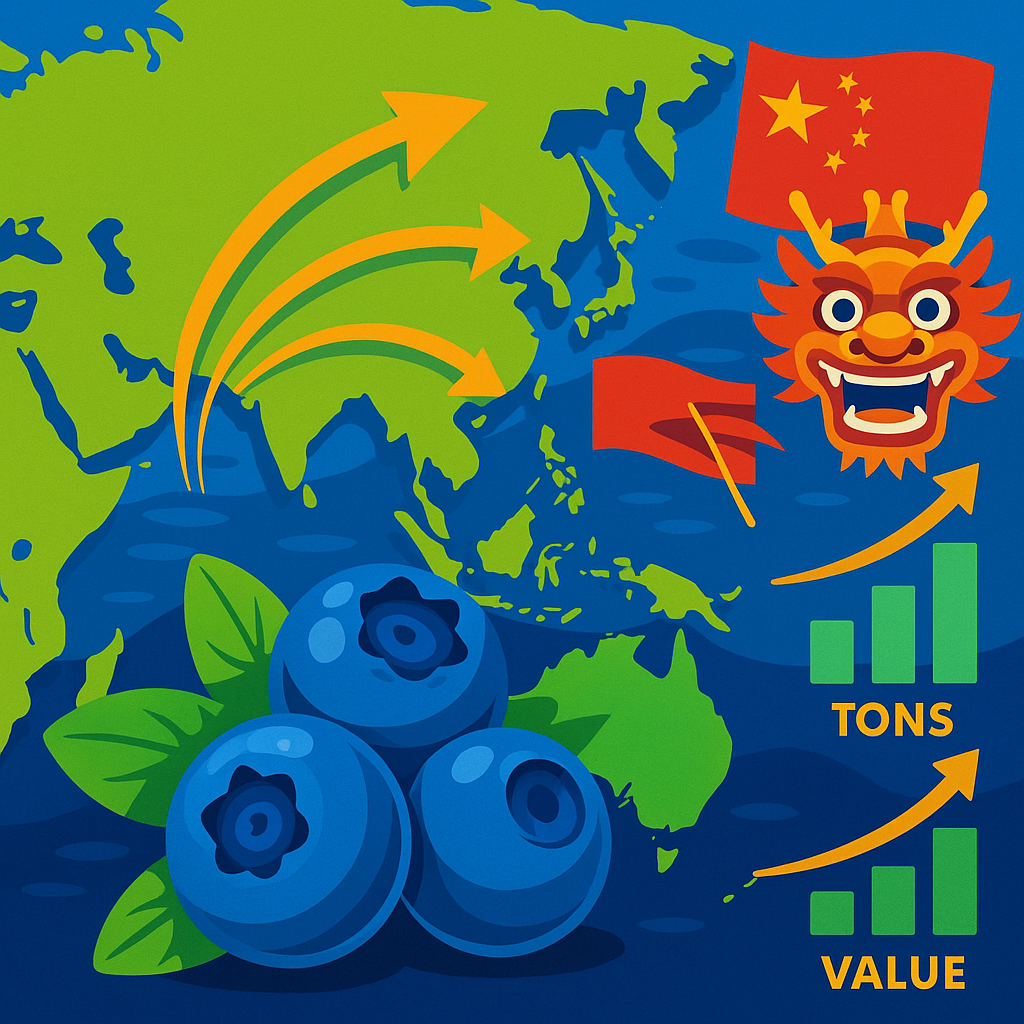Explosion of the Asian market for Latin American blueberries: 2025 figures and how to ride the export wave
Introduction
In just five years, the blueberry went from being a "niche" crop to one of the most dynamic fresh fruits in international trade. By 2025, Asia-Pacific has become the second largest destination for Latin American blueberries, surpassing the European Union and behind only the U.S. How big is the opportunity and how can growers and exporters capitalize on it? Below, we analyze the latest figures, logistical trends and phytosanitary requirements that dominate this new scenario.
1. Radiography of Latin American blueberry exports to Asia-Pacific
- Record volume: Latin America exported 212,000 tons of fresh blueberries in the 2024/25 season, of which 71,000 tons (33.5%) went to Asia-Pacific, compared to only 19,000 tons in 2020/21.
- Rising value: Latin American blueberry sales to the Asian bloc reached USD 1,505 million in 2024, with a compound annual growth rate of 36% since 2020.
- Top 3 exporters to Asia (2024): Peru (41,000 t), Chile (17,800 t) and Mexico (7,500 t).
- Main destinations: Mainland China absorbs 59 % of Latin American blueberry in Asia; followed by Hong Kong (14 %), Singapore (8 %), South Korea (7 %) and Japan (6 %).⁴
Why did Asia "fall in love" with the Latin American blueberry?
- a) Consumer changes
- China's per capita disposable income doubled between 2013 and 2023; spending on "healthy premium" products grows 17 % annually.⁵
- South Korea and Singapore exceed USD 45 in per capita consumption of berries, while Japan reaches USD 32.⁶
- b) Counter-seasonal advantage
- The Latin American commercial window (Sept-Mar) coincides with the low season for local Chinese production and with the consumption peaks for holidays (Golden Week and Lunar New Year).
- c) Impact of trade agreements
- The CPTPP eliminates tariffs for Peru and Chile in Japan, Malaysia and Vietnam.
- The Comprehensive Economic Partnership Agreement between Peru and China (effective March 2024) reduced the tariff on fresh blueberries from 10 % to 0 %.⁷
3. Technical barriers and value-added opportunities
- Maximum Residue Tolerance (MRL)
- China adjusted 2024 MRLs for fludioxonil to 5 ppm and azoxystrobin to 2 ppm for blueberries; failure to comply results in immediate rejections.⁸
- Cold logistics
- 87 % of Peruvian shipments to Shanghai and Qingdao already use "controlled atmosphere" (CA) technology; reduces post-harvest losses by 20 %.
- Certifications
- GLOBALG.A.P. and GRASP are requested by 92% of Korean importers.
- High margin processing
- Freeze-dried blueberries: average FOB price USD 28 /kg (vs. USD 8 /kg fresh).
- Nutraceutical powder: projected CAGR 2025-2030 of 18% in China.¹⁰
4. Recommendations for new Latin American exporters
- Plan the harvest based on direct flights: In 2025 there are six new Lima-Canton and Santiago-Incheon cargo air routes; reducing "field-gondola" to 38 h multiplies the value by 1.4 x.
- Implement IoT temperature and ethylene sensors in CA containers; over-ripening rejections dropped from 7% to 2% among exporters adopting this technology.¹¹¹
- Develop a methyl bromide-free postharvest protocol; South Korea bans it in 2026.
- Leveraging blockchain traceability: Alibaba Fresh and JD.com pay an 11% premium to lots with individual QRs.
- Consider the digital Phytosanitary Issuance and Tracking (PHIS) certificate; it reduces clearance in Chinese ports by two days.
Conclusion
The Asian boom in Latin American blueberries is not a passing fad: export revenues could exceed USD 2.6 billion by 2027 if the current growth rate is maintained. Training in phytosanitary requirements, optimizing cold logistics and moving towards high value-added formats are the levers to capture that opportunity.
Ready to design your blueberry strategy to Asia? At sembrar.info we have market intelligence tools, logistics cost simulators and certification advice to help you take the next step, contact us today and become the next successful exporter!
References
- ¹ International Trade Centre (ITC), Trade Map, accessed: May-2025.
- ² FAO, FAOSTAT trade database, 2025 edition.
- Customs of Chile, SUNAT (Peru) and SAT (Mexico), reports 2024.
- ⁴ General Administration of Customs, China, "Monthly Import Data," Apr-2025.
- ⁵ National Bureau of Statistics of China, Disposable Income 2013-2023.
- ⁶ Euromonitor, "Berries Consumption in Asia," ed. 2024.
- ⁷ Ministry of Commerce of the People's Republic of China, "China-Peru FTA Upgrade," Mar-2024.
- ⁸ China National Health Commission, Bulletin No. 11-2024.
- ⁹ Association of Blueberry Producers of Peru (PROARÁNDANOS), Logistics Report 2025.
- ¹⁰ Grand View Research, "Asia Pacific Blueberry Extract Market," Mar-2025.
- ¹¹ SmartCold Logistics, "Impact of IoT on berry exports", Dec-2024.




